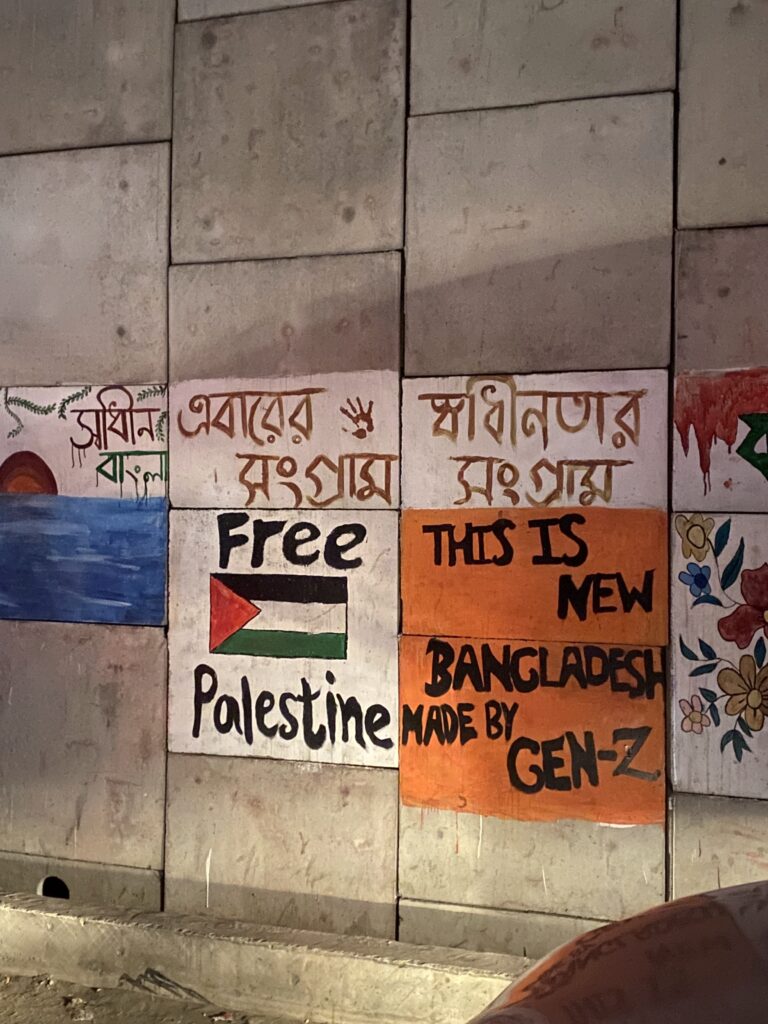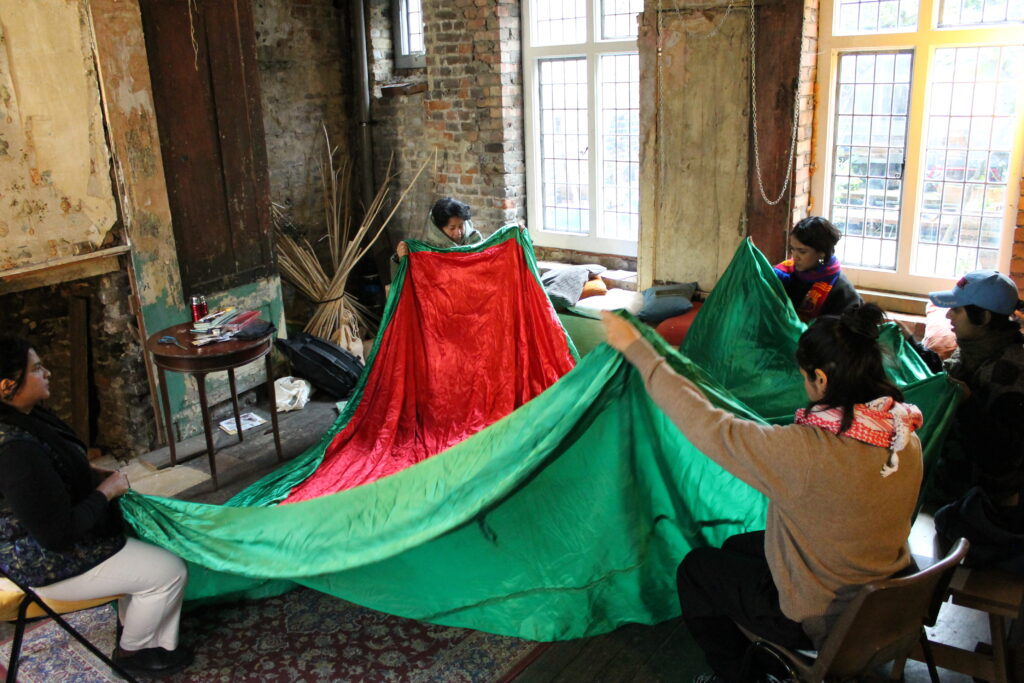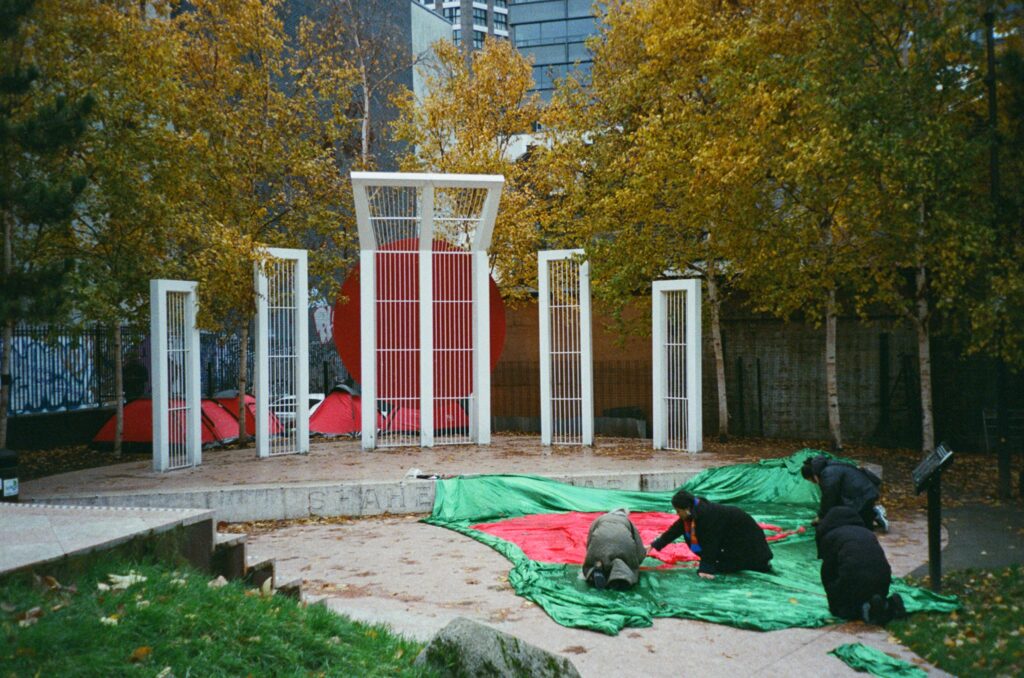Irresolute repairs, pending revolution | Rahila Haque
21st March 2025This text was written in response to artist Farida Yesmin’s workshop and participatory performance Stitching Bangladesh, held at the House of Annetta and Altab Ali Park in London on 27 November 2024. Executively produced by Giulia Casalini and funded by ARTCRY. The project was produced by Puer Deorum, who commissioned the written response by Rahila Haque.
Listen to the text read by Rahila Haque and Farida Yesmin here:
We’re only a few minutes out of Dhaka airport, when I see the first of the graffiti, covering the concrete walls and barriers along the highway. A succession of colourful images and text is painted along the route towards my parents’ apartment. When we slowdown in traffic, I quickly get a photo of one piece that reads This is new Bangladesh made by Gen Z and next to it, Free Palestine. The student-led revolution that had been so difficult to fathom and fiercely conflicted since it took place last summer, was holding on tightly to its vision through these bold declarations of freedom and solidarity. Over the next days I saw revolutionary graffiti across the entire city, most densely concentrated around Shahbag Square where many protestors had gathered—the site of massive protests in 2013. The authoritarian parade of banners and flags that had increased in density over the years, lining every major road with stately portraits of deposed Prime Minister Sheikh Hasina and her father Shiekh Mujib, had all disappeared. The mass movement that had rejected the nation’s purported heroes had made an indelible mark on the urban landscape, erasing any trace of Hasina’s once unavoidable and seemingly unshakeable political power.

In June 2024 students began protesting to demand the end of Sheikh Hasina’s Awami League government quota system which reserved 30% of all public sector jobs for the descendants of freedom fighters—those that had fought for Bangladesh’s liberation in 1971 under the leadership of Sheikh Mujib. The protests were brutally attacked and supressed by the authorities and the Awami League’s student wing, leading to an escalation from the students’ specific demands regarding job quotas, to a mass pro-democracy movement against Hasina’s autocratic and corrupt 16 year regime; one that had long repressed dissent with arrests, torture, enforced disappearances and rigged elections. On 5 August 2024 after weeks of internet blackout, brutal violence and chaos across the country, Hasina was unable to hold on to power and fled the country. In Dhaka 5 months later, I am in a city altered by the hope-filled aspirations of a new generation, but with a palpable anxiety around the immense power vacuum and the continuous wave of violent retribution and opportunistic manoeuvring by previously silenced opposition parties and extremist factions. The change that many young people had courageously fought and died for among a total of 1,400 martyrs, in an uprising that they justly claim as their victory, is mired in fear and uncertainty.
বাংলাদেশ এখন আঘাতপ্রাপ্ত,there’s a lot of violence and looting. Everyone is an individual.
কারো মতের সাথে কারে মত এক নয়।
কিন্তু ষোল বছর পরে যখন একটাফ্যাসিবাদী সরকারের পতন হয়, a tyrant, তখনতো এ রকম হওয়ারই কথা,তাই না? সেই দেশটাকে কি ঠিকভাবে পাবেন আপনি? যখন একটা tyrant ষোলবছর ধরে একটা দেশটাকে, destroy করে যায় every সেক্টরে?
মেনে নিলাম যে একটা শাসনব্যবস্থা যখন ব্যর্থ হয়,তখন নানা অরাজকতা ভিতর দিয়ে দেশটা যায়। It’s possible to think about what could happen. Now, in three months, more than that, with the recent rule, there is no…they can’t keep people safe, you know.

On a rainy day in November 2024, artist Farida Yesmin has invited women from the Bangladeshi diaspora to the House of Annetta to participate in her workshop and performance Stitching Bangladesh. We are just off Brick Lane and we will move later to Altab Ali Park, traversing two significant places for the Bangladeshi diaspora in London. At the centre of our gathering is a huge Bangladeshi flag—a tactile element that connects us, as we sit in a circle and pass the edges between our fingers, rotating it as we follow Farida apa, who also guides our breath. We eventually settle into the space enough to begin, at her request, sharing our thoughts and feelings on the summer’s student-led revolution in Bangladesh. During these few hours, we converse and come to know and situate each other a little, as we discuss the trauma, violence and insecurity that continues to engulf Bangladesh at this epochal shift. Later, Farida apa invites us to take turns in cutting the flag into pieces, before we walk down Brick Lane to the park. We lay it on the wet concrete ground by the replica Shahid Minar and, on our knees with numb fingers, stitched the flag back together. The park was empty but the presence of history, of its many martyrs, was tangible. The problem of nationalism engulfed us in layers.
যখন আমি তরুণ ছিলাম, তখন রাজনীতি নিয়ে ভাবতাম না। এখন আমি একজন মধ্যবয়সী নারী, এখন আমার মনে হয় রাজনীতিতে সবকিছু নিহিত। একজন নারী শিল্পী হিসেবে আমি নারী স্বাধীনতার কথা বলেছিলাম। So it is a part of politics.
That day, we were a temporary community of women and non-binary people who connected under the premise of a shared heritage and gendered experience. The nuance of how each of us situated ourselves in relation to the politics of a place that we don’t reside in, and have vastly different associations with, emerged as we spoke. There were differing opinions on and observations of what had passed, the experiences of our friends and families, and what it means to be in this limbo where questions around truth and justice remained unanswered, or unknowable. Farida apa’s own experience of being exiled from Bangladesh and seeking asylum in the hostile British state, sat in stark contrast to myself and others in the group—those who had left Bangladesh by choice or under easier conditions, and those of us whose relationships with Bangladesh are generationally (and geographically) removed from traumatic histories of genocide and colonial devastation.

I’m interested in the idea of a post-mortem—cutting, sewing, and investigating the cause of death.
What happens when a political dream dies? What about when one dream accuses another of causing its death? I think Farida apa gathered us to collectively address such questions and frictions, and it gradually became apparent that different dreams were being mourned. While none of us was involved in the movement, we pointed to the many positions, desires, goals and issues that characterise a mass political uprising—the kind of uprising that some of us wish for where we are—that, even in its success, is inevitably tarnished and fractured. Hannah Proctor writes about the psychic processes bound up with political struggle and defeat: the cumulative impact of struggle, generational trauma and exhaustion that go hand-in-hand with adapting to change, healing, integrating new horizons and finding renewed hope. I think of the young women who were at the forefront of the student movement and faced gender-based violence, resisting in not only a long lineage of student struggle, but also the birangona who survived the horrors of mass rape during ’71. Many are disturbed by the trampling of the memory and sacrifices of ’71, but perhaps the narrative that has become tethered to power, figureheads and museums, is in the process of being reclaimed for the people. If questions of reverence can be put aside, can the people’s histories ascend in such a moment and be counted from a different vantage point? What if we envisage ’71 as having been, as abolitionists and decolonial thinkers such as Ruth Wilson Gilmore and Ariella Aïsha Azoulay might propose, a rehearsal for 2024? The latter not a break with history but part of one continuum of struggle against tyranny, even if there is an urge to disassociate the two.
I do believe, recognise and respect ’71. Without ‘71 we wouldn’t be here. That’s so important. Giving respect. They’re now disrespecting everyone—teachers, freedom fighters, lawyers, everyone. With mass beatings, mass killing. Where is the respect? Where is the truth? Who told them to take the rules into their own hands?
A lot of the activists in my circle, they also want to remember ‘71. They don’t believe in destroying everything about Sheikh Mujib’s legacy…But they were saying that it’s really nuanced. Like, on one hand they support 1971 but on the other hand, [Mujib] was also corrupt. He was also doing things. And, you know, there’s no such thing as a hero…I agree, like, just always reacting and thinking that you’re going to over overthrow a past system is, is not going to be useful, necessarily, but I think that a lot of the student movement, they are talking about that.
While the movement ignited by students and carried by the masses defeated the government and its arbiters of extreme state violence, the present period of flux—an unelected interim government, the rise and influence of Jamaat-e-Islami, and the new student-led Jatiya Nagorik party— leaves a gaping chasm instead of the desired reassurance and resolution. As we spoke to each other that day in London, I filled that chasm with the immediate but unspoken anxieties of our own political abyss, in a country closing in on the promise of fascism, listening to those in power repeatedly support genocide, in a perpetual cost of living and housing crisis. Much of our discussion at a distance from the movement had at its core a painful ambivalence, of not knowing how those that have boldly stated their radical ambitions, are going to bring change in the face of such deep and devouring antagonisms. And, also, what are we going to do from where we are?
It somehow has to be joined to form a circle.
I feel like I’m stitching a kantha.
কাঁথা সিলাইয়ের মতো। কাঁথা সিলাইয়ের মাধ্যমে মানুষ তার নিজের গল্প তুলে ধরে।
হ্যাঁ, নকশীকাঁথা।
Freedom fighter Shib Narayan Das designed the first iteration of Bangladesh’s flag; a green background representing the country’s lush landscape with a red disc representing the rising sun of independence and its bloody struggle, with an outline of the country’s map at the centre. This version accompanied the freedom struggle; the map was removed after independence to leave the plain red disc on green, as it remains today. The flag is deeply tied to the memory of liberation, it was raised again in victory by the masses on 5 August at Ganabhaban, the prime minister’s residence, and Jatiya Sangsad Bhaban, the national parliament building. In some places, it was hoisted alongside the Palestinian flag to leave no doubt that this was a liberation struggle led by a movement with international solidarities, recognising Palestine as the compass of all our liberation struggles. In turn, they were acknowledged by their student comrades across the globe who are being violently suppressed for demanding an end to all complicity in the genocide of Palestinians. The revolution in Bangladesh pointed, fleetingly, to possible horizons elsewhere.

As we stitched the flag beside the Shahid Minar, the ghosts of student martyrs of the 1952 Bengali Language Movement became part of the deep well of history conjured by the flag’s symbolic weight. In our process of cutting the flag and stitching it back together, there was an unaddressed question about reforming the nation state. In the high of the immediate aftermath of the revolution, there opened briefly the possibility for imagining something radically different to the old ways, watching students hold press conferences and unprecedently take charge of the country. Some of that possibility has diminished in the months that have followed, but this tension of what is established by state boundaries and their inherent exclusions, between the cause of liberation and practice of hypernationalism, has been impressed upon the flag since it was conceived. In suturing the wounds we had inflicted on it, I wondered if the flag had garnered more integrity from our collective intervention, if it now more closely represents the agonising but evolving continuum at the core of revolution, or simply the scars of an undead state.
All quotations in the text are drawn from conversations between artist Farida Yesmin and workshop participants.
Rahila Haque is a curator, writer and researcher whose work engages with artistic practices that bring aesthetics into dialogue with political urgencies, anticolonial histories and feminist epistemologies. She is a PhD candidate at the centre for Transnational Art, Identity and Nation (TrAIN) at Chelsea College of Arts. She has curated solo exhibitions by Imran Perretta (2024) and SERAFINE1369 (2022) at Somerset House Studios, London and has previously worked with Iniva, Camden Art Centre, Tate, and the Hayward Gallery. In 2019 she was Assistant Curator for the 58th Venice Biennale exhibition. Recent writing has been included in Subcontinental Synthesis Electronic Music at the National Institute of Design, India 1969–1972, ed. Paul Purgas (2024) and Alia Syed: Imprints, Documents, Fictions, ed. María Palacios Cruz (2023).
Main image credits: Stitching Bangladesh. Credits Puer Deorum